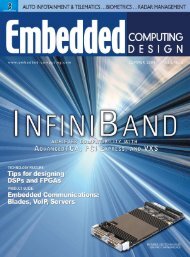CompactPCI and AdvancedTCA Systems - OpenSystems Media
CompactPCI and AdvancedTCA Systems - OpenSystems Media
CompactPCI and AdvancedTCA Systems - OpenSystems Media
Create successful ePaper yourself
Turn your PDF publications into a flip-book with our unique Google optimized e-Paper software.
Consumer pressuresService providers must simultaneouslyaddress customers’ dem<strong>and</strong>s for increasingapplication complexity while deliveringservices at lower cost. At the sametime advances in technology, especiallythe network, are driving dem<strong>and</strong>s for highb<strong>and</strong>width 24x7 services.Business pressuresWe still have the development cycles weinherited from the dot-com era, but notthe financial exuberance. Service providersare expected to accomplish more <strong>and</strong>in less time, but for less cost than everbefore. R&D budgets <strong>and</strong> operationalcosts are being slashed, yet at the sametime providers must increase margins.Competitive pressuresTo add to the problems, in today’s confusinglyfast-paced business environment,product differentiation is more importantthan ever. The competitive field is stronger,<strong>and</strong> providers must get to market faster withbetter functionality than the competition.One way that NEPs are relieving thesepressures is by creating universal platformsthat can be reused to build futureproducts. This is where the use of reliable,commercial grade COTS components canprovide significant cost benefits frombuilding in-house solutions. Open sourcesoftware enables leading edge technology<strong>and</strong> best-of-breed commercial solutionsfrom ISVs <strong>and</strong> HW vendors. In addition,NEPs have access to all the functionalitythey need to develop state-of-the-art NGNsolutions while also providing them withthe control they need over their individualprojects. Using these COTS-based platformsallows the NEPs to focus on theircore value <strong>and</strong> still differentiate theirproducts <strong>and</strong> services. These COTS-baseduniversal platforms can then be reused fora multitude of NGN network elements,driving down costs <strong>and</strong> time to market.Industry organizationsdriving COTSHistorically one of the challenges thatNEPs face in achieving COTS solutions isthe high cost <strong>and</strong> difficulty of integratingthese COTS building blocks into reusable<strong>and</strong> interoperable components. In orderfor these COTS components to be trulyreusable <strong>and</strong> interoperable, st<strong>and</strong>ardsmust be created to define the availableservices <strong>and</strong> the APIs that interface tothose services. Many industry organizationshave formed over the last few yearsto help grow <strong>and</strong> promote the ecosystemfor COTS components being used in thetelecommunications industry.Open Source DevelopmentLabs (OSDL)Recognized as the center of gravity forLinux, OSDL is dedicated to acceleratingthe use of Linux in all markets. OSDL isa key contributor to the COTS TelecomSolution Stack through sponsoring theCarrier Grade Linux Working Group. Thisis a group of Linux distributors, HW platformproviders, <strong>and</strong> NEPs that are drivingspecifications for the st<strong>and</strong>ardization of aCarrier Grade Linux (CGL). Already inits second release, the CGL specificationis the foundation of most COTS-basedsolution stacks being designed today.PCI Industrial ComputerManufacturers Group (PICMG)PICMG is a consortium of more than 450companies who collaboratively developopen specifications for high performancetelecommunications <strong>and</strong> industrialcomputing applications. Recently,PICMG announced the developmentof a new series of specifications, called<strong>AdvancedTCA</strong>, for next generation telecommunicationsequipment, with a newform factor, <strong>and</strong> based on switched fabricarchitectures. <strong>AdvancedTCA</strong>’s successin the market has far exceeded initialexpectations. Nearly every major NEPis planning <strong>AdvancedTCA</strong>-based NGNsolutions.Service Availability Forum (SAF)The SAF goal is the adoption of openst<strong>and</strong>ards to enable the industry to buildhigh availability network infrastructureproducts, systems, <strong>and</strong> services. TheSAF is driving interface specificationsto ensure high availability of services. AsNEPs move towards a COTS model, theywill need assurances that these new COTSapplications will have the same level ofservices <strong>and</strong> availability as their legacyin-house solutions. The SAF is definingkey services <strong>and</strong> the interfaces betweenthe hardware platform, the operatingsystem, <strong>and</strong> the High Availability (HA)middleware. The SAF is driving three keyinterface specifications:■ The Hardware Platform InterfaceSpecification (HPI) defines the interfacesbetween the hardware <strong>and</strong> theoperating system <strong>and</strong> middleware.■ The Application InterfaceSpecification (AIS) defines interfacesfor how HA middleware services communicatewith each other <strong>and</strong> with theoperating system. The AIS defines keyservices required for a complete HAsystem, including messaging, clustermembership, check-pointing, eventmonitoring, <strong>and</strong> frameworks.RSC# 31 @www.compactpci-systems.com/rsc
















